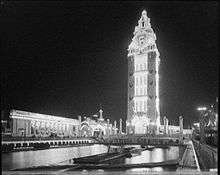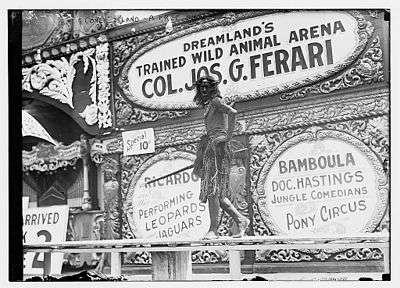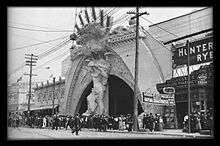Dreamland (amusement park)
|
Dreamland park in 1907 | |
| Location | Coney Island, Brooklyn, United States |
|---|---|
| Coordinates | 40°34′37″N 73°58′44″W / 40.577°N 73.979°W |
| Owner | William H. Reynolds |
| Opened | 1904 |
| Closed | Destroyed by fire in 1911 |
Dreamland was an ambitious amusement park at Coney Island, Brooklyn, New York City from 1904 to 1911. It was the last, and considered the grandest, of the three original iconic large parks built on Coney Island, the other two being Steeplechase Park and Luna Park.[1]
History and description
Creation

The park was founded by William H. Reynolds, a former state senator and successful Brooklyn real estate developer.[2][3][4] He designed the park to compete with Luna Park, a neighboring amusement park opened in 1903. Dreamland was supposed to be refined and elegant in its design and architecture, compared to Luna Park with its many rides and chaotic noise.[5]
Reynolds purchased a 15-acre (6.1 ha) parcel at Surf Avenue and West Eighth Street on which to build the park, using proxy buyers in order to hide his real ambitions for the lot. Once he bought the site, he used political power to demolish West Eighth Street in order to expand the lot. Today, the site is near the site of the West Eighth Street subway station opposite Culver Depot, the then-terminal of New York City Subway's BMT Brighton Line and BMT Culver Line. The site is now the location of the New York Aquarium and the adjacent subway station.[5]
Description

Opened on May 15, 1904, Dreamland was a park in which everything was reputed to be bigger and more expansive than in neighboring Luna Park.[2] Dreamland had a larger central "Tower" and one million electric light bulbs illuminating and outlining its buildings,[5][6] 4 times as many lights as Luna Park.[5] Dreamland featured relatively high-class entertainment and dramatic spectacles based on morality themes such as "The End of the World" and the Orient Theater's "Feast of Beshazzar and the Destruction of Babylon."[7] It also featured elegant architecture, pristine white towers, and some educational exhibits along with the rides and thrills.
Among Dreamland's attractions were a railway that ran through a Swiss alpine landscape, imitation Venetian canals with gondolas, a "Lilliputian Village" with three hundred dwarf inhabitants, and a demonstration of firefighting in which two thousand people pretended to put out a blazing six-story building fire every half-hour.[5] However, many rides were imitations of Luna Park's. There were also two Shoot-the-Chutes with two ramps that could handle 7,000 hourly riders, a scenic railway called Coasting Through Switzerland, gondola rides through a nighttime model of Venice, a miniature railroad, and a simulated submarine ride. The side shows were owned by the Dicker family, who also owned the hotel next to the park. There was also a display of baby incubators, where premature babies, triplets who were members of the Dicker family, were cared for and exhibited. The doctors advised them of the new invention, but they could not use it because incubators were not approved for use in hospitals, so the triplets were placed in the side show, which was allowed. Two survived and lived on to have full lives.[5]
In a bid for publicity, the park put famous Broadway actress Marie Dressler in charge of the peanut-and-popcorn stands, with young boys dressed as imps in red flannel acting as salesmen. Dressler was said to be in love with Dreamland's dashing, handlebar-mustachioed, one-armed lion tamer who went by the name of Captain Jack Bonavita.[6] Bonavita, who commanded lions in the Bostock animal arena, had one arm amputated when his hand was severely clawed by one of the lions, and a blood infection spread through that hand.[5]
Destruction

In spite of its many draws, Dreamland struggled to compete with Luna Park, which was better managed.[5] In preparation for its 1911 season, many changes were made. Samuel W. Gumpertz (later director of the Ringling Brothers and Barnum & Bailey Circus) was put in the park's top executive post. The buildings, once all painted white in a bid for elegance, were redone in bright colors. On the night before opening day, a concession called Hell Gate, in which visitors took a boat ride on rushing waters through dim caverns, was undergoing last-minute repairs by a roofing company owned by Samuel Engelstein. A leak had to be caulked with tar. During these repairs, at about 1:30 in the morning on May 27, 1911, the light bulbs that illuminated the operations began to explode, perhaps because of an electrical malfunction. In the darkness, a worker kicked over a bucket of hot pitch, and soon Hell Gate was in flames.[5]
The fire quickly spread throughout the park. The buildings were made of frames of lath (thin strips of wood) covered with staff (a moldable mixture of plaster of Paris and hemp fiber). Both materials were highly flammable, and as they were common in the Coney Island amusement parks, fires were a persistent problem there. Because of this, a new high-pressure water pumping station had been constructed at Twelfth Street and Neptune Avenue a few years earlier, but on that night it failed. Water was available, but there was not enough to contain the fire that enveloped Dreamland. The Dicker family's adjacent hotel also burned down in this fire.[5]

Chaos broke loose as the park burned. As the single-armed Captain Bonavita strove to save his big cats with only the swiftly encroaching flames for illumination, some of the terrified animals escaped, but about 60 animals died. A lion named Black Prince rushed into the streets, among crowds of onlookers, and was shot by police. By morning, the fire was out and Dreamland was completely destroyed and never rebuilt.[5] Early editions of The New York Times claimed the incubator babies had perished in the flames, but later the paper corrected this and reported that they had all been saved. According to contemporaneous accounts, a number of these saves were accomplished by Sgt. Frederick Klinck of the NYPD, who made several trips into the burning structure to rescue incubator babies.[5]
Almost ten years after the fire, Reynolds, who by then owned the majority of Dreamland's outstanding bonds and stood to make a windfall, used his political connections to have New York City purchase the land on which Dreamland once stood.[2] The city bought the area, valued at $1.5 million, for $1.8 million.[5]
In popular culture

Art
- Artist Philomena Marano created a body of work inspired by the park in the papier collé method, American Dream-Land.[9][10]
Literature
- Kevin Baker wrote a historical novel, Dreamland, about life in New York City at the time Dreamland existed, touching on the politics, economics, social conditions of the time, and Dreamland is one of the central places in the book. His book also contains a description of the fire. The following is an excerpt, in which he describes one of the very common fatal accidents at amusement parks of the time:
The greatest roller coaster ride of all time took place on a balmy Sunday afternoon on Coney Island on September 6, 1901, at 4:07 P.M. It was on a new coaster, called The Rough Rider, where each train was run by its own motorman. Done up in full San Juan Hill regalia. Instructed to make 'em scream, the louder the better--that's what brings in the paying customers. Until that afternoon when one of the ersatz Teddies, pushing his train at full speed, snapped off the rear two cars and sent them soaring out, sixty feet into the air above Surf Avenue. After the accident they didn't close The Rough Rider, or even change it. The crowds were greater than ever for the roller coasters--thanatos and eros, the death wish and the pleasure principle, all at the same time. You could see them in the long line, staring avidly at the twisted track, the hole in the guard rail where it had smashed through. Wondering what it was like-- The cars rising slowly along the impossibly steep track, jerking and grating on their chains. The dread growing steadily in the pit of the stomach, until that last, awful moment, when you pause for a moment at the peak, and look down over the impossibly narrow, curving track, face-to-face with what you have done. Yet always sure that at the very end, you will be pulled back from the brink-- Did they understand it? That's what all the gawkers, the rubberneckers in line wanted to know. After the impossible happened, and the chain broke, and they crashed through the last barrier--did they understand in those last, suspended moments above Surf Avenue, before they hit the ground, that theirs was the greatest thrill of all?
- Dutch writer J. Bernlef's novel De witte stad (The White City) narrates about the fictional lives of many Dreamland inhabitants.
- Dutch writer Arthur Japin's novel De grote wereld (The Big World), about two midgets, is partly set in Dreamland.
- Dutch architect Rem Koolhaas writes at length on Dreamland in his retroactive manifesto for Manhattan, Delirious New York.
- Dutch writer Peter Verhelst's novel Geschiedenis van een berg (History of a mountain) about a park based on Dreamland, called 'Droomland' (Dreamland).
- Henry Miller mentions Dreamland in his novel, Tropic of Capricorn: I was walking again in Dreamland and a man was walking above me on a tightrope and above him a man was sitting in an airplane spelling letters of smoke in the sky.
- Steven Millhauser, in his short story "Paradise Park", also talks about Dreamland as a rival amusement park. There are some similarities between Paradise Park and Dreamland.
- Fannie Flagg, in "Standing in the Rainbow", referred to Dreamland as being 'so big they had an entire little town there'.
- American author Alice Hoffman writes about Dreamland in her 2014 novel of historical fiction entitled "The Museum of Extraordinary Things." The book is set in New York City in the early 1900s and includes the Dreamland fire in the plot, as well as the Triangle Shirtwaist Factory fire.
- American author Christopher Bram sets the last part of his novel at Dreamland, in his 2000 novel of historical fiction entitled "The Notorious Dr. August: His Real Life and Crimes." The major character of the novel is conceived as one of the major "acts" at Dreamland in an extensive treatment of the setting.
- In the novel Home by Daniel Martin Eckhart, one plotline takes place on May 26 and 27, 1911. It depicts life at Dreamland, in the anticipation of the season's opening the following day. The novels also details the night of the fire, from salvation efforts to final destruction. Historical figures such as Samuel W. Gompertz and Captain Jack Bonavita are built into the story.
Music
- Tom Waits wrote the song "Tabletop Joe" in which the title character is himself part of the freak show exhibit, "a man without a body," but Joe becomes rich and famous as a part of the Dreamland show, and after being shunned, after joining Dreamland, he now feels that he is where he belongs.
- Brian Carpenter wrote a play treatment which he used as a springboard for lyrics and compositions behind his second studio album for Beat Circus entitled Dreamland. Carpenter's Dreamland is a 150-page score and song cycle interwoven with Carpenter's fictional tale of an impoverished, alcoholic gold miner who makes a pact with the devil before fleeing eastward to work in Dreamland's sideshows. The album featured Todd Robbins, alumnus of Coney Island, and its booklet includes historical images of Dreamland donated by the Coney Island Museum.[11]
See also
References
- ↑ David Goldfield, Encyclopedia of American Urban History, SAGE Publications - 2006, page 185
- 1 2 3 David A. Sullivan. "Dreamland (1904-1911)". www.heartofconeyisland.com. Retrieved February 5, 2016.
- ↑ Ultimate Rollercoaster, LLC (1996–2012). "Roller Coaster History: Early 1900's: Coney Island". rollercoaster.com. Retrieved June 25, 2012.
- ↑ "Walkabout: William H. Reynolds, conclusion". Brownstoner.com. Retrieved June 25, 2012.
- 1 2 3 4 5 6 7 8 9 10 11 12 13 "At Hell's Gate: The Rise and Fall of Coney Island's Dreamland". Entertainment Designer. February 4, 2012. Retrieved June 25, 2012.
- 1 2 Edo McCullough (1957). Good Old Coney Island: A Sentimental Journey Into the Past - the Most Rambunctious, Scandalous, Rapscallion, Splendiferous, Pugnacious, Spectacular, Illustrious, Prodigious, Frolicsome Island on Earth. Fordham University Press. p. 198.
- ↑ pbs.org The American Experience, People & Events Luna Park Opens
- ↑ Michael Immerso, Coney Island: The People's Playground, Rutgers University Press, 2002, page 73
- ↑ Denson, Charles, "Coney Island Lost and Found," Ten Speed Press, 2002, pages 227-231
- ↑ Breuckelen Magazine Video "Interview with Philomena Marano" June 2014
- ↑ Webster, Sarah (February 1, 2008). "Circus Coming To Town". Asbury Park Press. Retrieved February 2, 2008.
External links
| Wikimedia Commons has media related to Dreamland. |
- Dreamland at amusement-parks.com
- Maps and postcards of Dreamland
- Dreamland Park History
- Dreamland and William Reynolds at Heart of Coney Island
